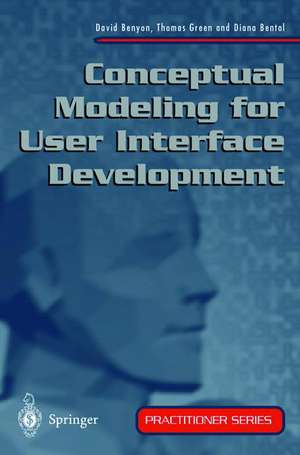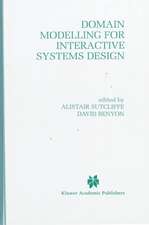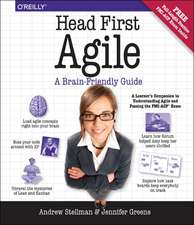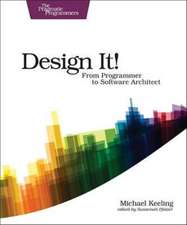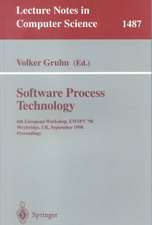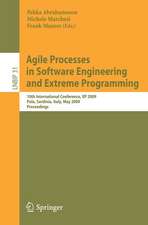Conceptual Modeling for User Interface Development: Practitioner Series
Autor David Benyon, Thomas Green, Diana Bentalen Limba Engleză Paperback – 11 iun 1999
Din seria Practitioner Series
- 20%
 Preț: 337.52 lei
Preț: 337.52 lei - 20%
 Preț: 645.14 lei
Preț: 645.14 lei - 20%
 Preț: 333.54 lei
Preț: 333.54 lei - 20%
 Preț: 336.86 lei
Preț: 336.86 lei - 20%
 Preț: 332.24 lei
Preț: 332.24 lei - 20%
 Preț: 326.28 lei
Preț: 326.28 lei - 20%
 Preț: 344.76 lei
Preț: 344.76 lei - 20%
 Preț: 330.56 lei
Preț: 330.56 lei - 20%
 Preț: 333.04 lei
Preț: 333.04 lei - 20%
 Preț: 336.67 lei
Preț: 336.67 lei - 15%
 Preț: 646.94 lei
Preț: 646.94 lei - 20%
 Preț: 330.10 lei
Preț: 330.10 lei - 20%
 Preț: 332.24 lei
Preț: 332.24 lei - 20%
 Preț: 329.76 lei
Preț: 329.76 lei - 20%
 Preț: 328.27 lei
Preț: 328.27 lei - 20%
 Preț: 341.95 lei
Preț: 341.95 lei - 20%
 Preț: 328.42 lei
Preț: 328.42 lei - 20%
 Preț: 331.58 lei
Preț: 331.58 lei - 20%
 Preț: 326.13 lei
Preț: 326.13 lei - 15%
 Preț: 647.08 lei
Preț: 647.08 lei -
 Preț: 383.71 lei
Preț: 383.71 lei - 20%
 Preț: 355.14 lei
Preț: 355.14 lei
Preț: 327.77 lei
Preț vechi: 409.71 lei
-20% Nou
Puncte Express: 492
Preț estimativ în valută:
62.74€ • 68.17$ • 52.73£
62.74€ • 68.17$ • 52.73£
Carte tipărită la comandă
Livrare economică 21 aprilie-05 mai
Preluare comenzi: 021 569.72.76
Specificații
ISBN-13: 9781852330095
ISBN-10: 1852330090
Pagini: 204
Ilustrații: XIII, 187 p. 13 illus.
Dimensiuni: 155 x 235 x 11 mm
Greutate: 0.29 kg
Ediția:Softcover reprint of the original 1st ed. 1999
Editura: SPRINGER LONDON
Colecția Springer
Seria Practitioner Series
Locul publicării:London, United Kingdom
ISBN-10: 1852330090
Pagini: 204
Ilustrații: XIII, 187 p. 13 illus.
Dimensiuni: 155 x 235 x 11 mm
Greutate: 0.29 kg
Ediția:Softcover reprint of the original 1st ed. 1999
Editura: SPRINGER LONDON
Colecția Springer
Seria Practitioner Series
Locul publicării:London, United Kingdom
Public țintă
Professional/practitionerCuprins
1. Modeling in User Interface Development.- 1.1 User Interface Development.- 1.2 Principles of Design.- 1.3 Models in Design.- 1.4 User Interface Development: The Functional View.- 1.5 Models of Dynamics.- 1.6 Models of Structure.- 1.7 The Role of ERMIA in User Interface Development.- 2. An Introduction to ERMIA.- 2.1 Evaluating Designs and Devices.- 2.2 ERMIA in a Nutshell.- 2.3 Information Artefacts.- 2.4 The Uses of ERMIA.- 3. The Components of an ERMIA Model.- 3.1 The Components.- 3.2 Entity.- 3.3 Relationship.- 3.4 Attribute.- 3.5 Entity, Relationship or Attribute?.- 3.6 Example: A Database of Papers Submitted to a Conference.- 3.7 Example: Telephone Network.- 4. Conceptual and Perceptual ERMIAs.- 4.1 The Information to Be Displayed versus the Display Itself.- 4.2 Manifest and Conceptual Entities and Relationships.- 4.3 Perceptually-coded Attributes.- 4.4 Example: A List Viewport.- 4.5 Distributed Conceptual Information.- 4.6 Comparing Different User Views.- 5. Searching for Information.- 5.1 Information Can Be Hard to Find.- 5.2 The Five Types of Entity Store.- 5.3 Example: The List of Flowers Revisited.- 5.4 Searching More Complex Structures.- 6. Dealing with Complex Relationships.- 6.1 Decomposing Many-to-Many Relationships.- 6.2 Different Manifest Structures Lead to Different Search.- 6.3 Making Many-to-Many Relationships Easy to Explore.- 6.4 Example: A Drum Machine Pattern Sequencer.- 6.5 Fossil Silt.- 7. Standard Structures and Safe Paths.- 7.1 Standard Structures for Search.- 7.2 Safe Trails.- 7.3 Connection Traps.- 7.4 Short Cut Keys.- 8. Representing Different Views.- 8.1 Levels of Information Artefacts.- 8.2 Example: Currency Exchange.- 8.3 Different Views Facilitate Different Tasks.- 8.4 Representing Mental Models.- 9. Developing ERMIAs.- 9.1 ERMIA as aLanguage for Design.- 9.2 Heuristics for ERMIA.- 9.3 Methodology for ERMIA.- 9.4 Case Study: The Oven Hob Problem.- 9.5 Building the ERMIA.- 10. Practical ERMIA Modeling.- 10.1 The Appointments Diary.- 10.2 The Alarm Clock.- 10.3 The ATM.- 11. Case Study.- 11.1 The Domain.- 11.2 Conceptual ERMIA of XBarnacle.- 11.3 A Perceptual ERMIA of the XBarnacle Interface.- 11.4 Using ERMIA to Identify Potential Usability Problems.- 11.5 Did the problems materialize?.- 11.6 Introducing critics: XBarnacle.- 12. Conclusions.- 12.1 ERMIA and Other Techniques.- 12.2 Choosing a Modeling Method.- 12.3 Usability Issues.- 12.4 Future Developments.- Solutions to Exercises.- Summary of Notation.- Resources.
Caracteristici
It presents an insight into some of the most important ideas in human-computer interaction Introduces the novel technique of Entity-Relationship-Modelling and shows how the technique can be applied to interface issues Uses a tutorial style, so that the technique can be picked up and used by the reader
